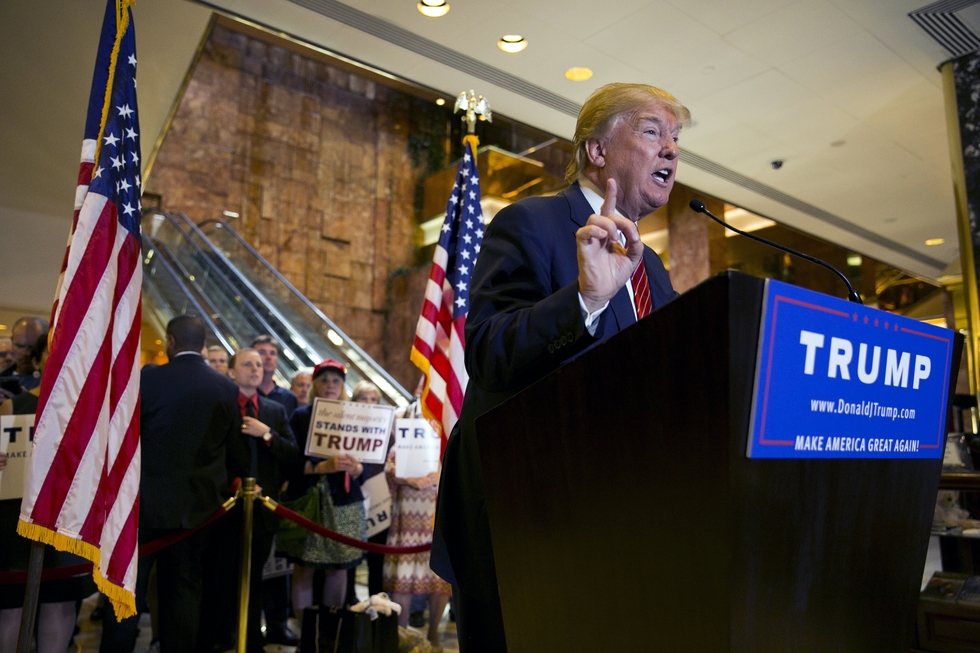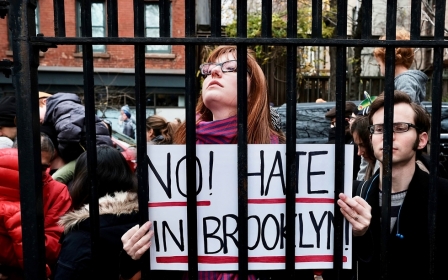Trump's tax plan won't benefit working class Americans, say experts

NEW YORK, United States – US president-elect Donald Trump has been relatively candid about his approach to taxes. Paying nothing into state coffers “makes me smart,” he said in a rebuff to his Democratic rival, Hillary Clinton, during a face-off in September.
After the billionaire Republican’s shock win over Clinton this month, analysts have pored over his many campaign-trail proclamations for clues of what to expect in January 2017 on everything from immigration to healthcare and foreign policy.
'You can’t give huge tax cuts to everybody and not have somebody pay for it' -Len Burman
On taxation, Trump’s promise of “across-the-board” cuts won him cheers, particularly among the blue-collar voters from rural and suburban parts of Pennsylvania, Wisconsin and other Rust Belt states that helped him win the White House.
But experts contacted by Middle East Eye said Trump’s sums do not add up.While his tax plans would herald cuts for poorer workers, those same folks would suffer from the broader economic malaise his policies would precipitate, analysts explained.
“Follow the old adage that your mother told you, which is if it sounds too good to be true, it probably is. You can’t give huge tax cuts to everybody and not have somebody pay for it,” Len Burman, director of the Urban-Brookings Tax Policy Center, told MEE.
“Donald Trump would say that he would cut spending and he’s also counting on some magic from his trade policy making the economy grow, which is not consistent with any economists’ view of the world.”
Over the weekend, the president-elect was holed up at his Trump National Golf Club in Bedminster, a typically-quiet part of central New Jersey that has suddenly become the epicentre of American politics with a stream of experts offering the soon-to-be leader their two cents.
In these meetings, he discussed “freeing up commerce” and creating jobs with Peter Kasinow, had an “in-depth conversation” on new tax laws with Blackstone Group LP's Jon Gray and “constructive” talks with Todd Ricketts, a co-owner of the Chicago Cubs, on reforms and “entrepreneurial initiatives”.
Campaign promises
It is possible, and even probable, that Trump will modify his tax plans before his inauguration on 20 January, but the president-elect’s website still stands by many of the policies he proposed on the campaign trail.
“If a tax code were designed to punish hard work, thrift, and investment, the current US tax code could serve as a blueprint,” his website says. “A Trump Administration tax plan can be summarised as lower, simpler, fairer, and pro-growth.”
He promises wholesale cuts and, in particular, a “massive tax reduction” for “working and middle-income Americans”. The rich will “pay their fair share,” but tax will not be so punitive that “it destroys jobs or undermines our ability to compete”.
Answering widespread gripes about an overly-complicated tax system, Trump promises to get rid of the seven tax brackets used to assess how much people pay, and to replace them with a simpler system with three categories.
Those on low incomes will effectively pay zero. For married couples who file tax returns jointly, those with a combined income of less than $75,000 will pay 12 percent, those earning from $75-$225,000 will pay 25 percent and those earning more than $225,000 will pay 33 percent.
He would also slash taxes on businesses to 15 percent, boost manufacturing and “make American great again” with economic growth rates of as much as 4 percent – levels that have not been seen in the US for decades.
According to the Urban-Brookings Tax Policy Center, the plan falls down on a cursory analysis. It would leave the federal government with a $6.2 trillion shortfall within its first decade and a further $8.9 trillion in its second decade.
Three quarters of this loss would come from Trump’s plan to slash business taxes.
Debt and interests
Analysts agree that everyone would pay less tax under Trump’s plan, but note that the rich get the best deal. The average tax bill would be cut by $2,940 in 2017 – increasing after-tax income by 4.1 percent.
Those among the top 0.1 percent of the population, with a 2016 income of more than $3.7m, would see tax cuts of $1.1m – representing a saving of more than 14 percent of after-tax income.
'Business is not investing because demand is weak, not because regulations or taxes are too high' -James Nolt
Households on mid-range incomes would receive an average tax cut of $1,010 (1.8 percent of after-tax income), while the poorest fifth of households would see their taxes drop by only about $110 (0.8 percent of after-tax income).
It could even get worse for the poorest, Burman said.
“If the consequence of the plan is that there’s a huge run-up in debt, that could hurt the economy,” Burman told MEE.
“That could eventually push up interest rates, which would make it harder for businesses to invest and for individuals to buy cars, homes and other-big ticket items. A lot of people could lose their jobs and wages would be lower than they would be otherwise.”
A separate study by Citizens for Tax Justice, another research group, reaches similar conclusions. Trump’s plan would reduce federal tax revenues by some $4.8 trillion over the next decade, with the richest top 1 percent of taxpayers making the biggest savings (44 percent of the cut).
“The largest tax cuts, as a share of personal income, would go to those in the top 1 percent of the income distribution,” the study said. “This group, with incomes averaging $1.7m in 2016, would receive tax cuts averaging 5.1 percent of their income or $88,000.”
James Nolt, a political economist at the World Policy Institute think tank, said Trump policies of trade protectionism and tax cuts would fail to deliver benefits to working Americans or the wider US economy.
“Established Republican solutions of tax and regulation cuts will not stimulate the economy very much. Most big corporations already find numerous ways to avoid taxes and game regulations,” Nolt told MEE.
“Business is not investing because demand is weak, not because regulations or taxes are too high. If companies are left with even more profits, they will not create millions of new jobs and a growth rate of four percent, but will further inflate asset values with their speculative games.”
Marc Goldwein, an analyst from the Committee for a Responsible Federal Budget, a public policy think tank, said Trump is likely conflicted between delivering on his campaign pledges and balancing the books.
“His administration must come to the terms with reality that they’ll be entering office with the highest debt of any president other than Harry Truman, and a debt that’s growing,” Goldwein told MEE.
“They’re going to need to come to terms with that and start a push for spending reforms and tax reforms that actually reduce the debt, because right now Trump’s plan would massively explode it.”
MEE contacted Trump’s transition team, but interview requests were not answered. Similarly, The Heritage Foundation and other conservative think tanks that advocate low-tax, high-growth policies, did not reply to requests for comment.
Middle East Eye propose une couverture et une analyse indépendantes et incomparables du Moyen-Orient, de l’Afrique du Nord et d’autres régions du monde. Pour en savoir plus sur la reprise de ce contenu et les frais qui s’appliquent, veuillez remplir ce formulaire [en anglais]. Pour en savoir plus sur MEE, cliquez ici [en anglais].




